History
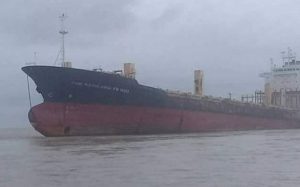 As kids, most of us hear a ghost story or two, but rarely was the “ghost” a ship. Nevertheless, ghost ships do occasionally find their way into folk lore, whether they are fact or fiction. Fictitious ghost ships would have their draw, because the storyteller can elaborate as much or as little as they want, but the non-fiction version is incredible, because it is true. One such real ghost ship is the Sam Ratulangi. This ship is a modern day version of the ghost ship. Built in 2001, the ship disappeared after only eight years of service.
As kids, most of us hear a ghost story or two, but rarely was the “ghost” a ship. Nevertheless, ghost ships do occasionally find their way into folk lore, whether they are fact or fiction. Fictitious ghost ships would have their draw, because the storyteller can elaborate as much or as little as they want, but the non-fiction version is incredible, because it is true. One such real ghost ship is the Sam Ratulangi. This ship is a modern day version of the ghost ship. Built in 2001, the ship disappeared after only eight years of service.
The disappearance is not totally unusual, but not being able to locate the ship is something else all together…especially in the year 2001. If a ship sinks, someone knows just about where to look, and with satellite coverage, someone will spot a ship that didn’t sink. And this was not small boat. The Sam Ratulangi is a huge cargo ship that is 580 feet long…not something that could be easily missed in the ocean. Nevertheless, for 9 years, there was no sign of the Sam Ratulangi. Most people assumed that the ship sank back in 2001, and gave up hope of ever finding it again.
People who love the beach, know that you often find things that have washed up on shore, but no one expected a 580 foot ship to suddenly show up within sight of the beach…bottles, driftwood, even parts of a ship wreck or plane crash, but not the whole ship, and definitely not after 9 years. Nevertheless, there it was just a 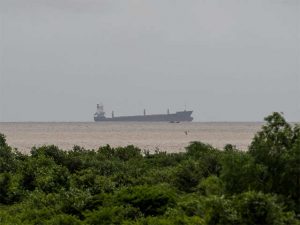 couple of miles off the coast of a village in Myanmar. The ship was empty, both of cargo and of crew. It is unknown exactly what happened to the crew. The ship is enormous, and it’s pretty hard to imagine someone not seeing this drifting out on the ocean, so why had it reappeared? It was visible from the shore, but someone had to be brave enough to go onboard to check it out. The ship was seized by the Myanmar navy, until more information could be found.
couple of miles off the coast of a village in Myanmar. The ship was empty, both of cargo and of crew. It is unknown exactly what happened to the crew. The ship is enormous, and it’s pretty hard to imagine someone not seeing this drifting out on the ocean, so why had it reappeared? It was visible from the shore, but someone had to be brave enough to go onboard to check it out. The ship was seized by the Myanmar navy, until more information could be found.
The appearance of the Sam Ratulangi was a mystery, but soon there was a clue that could lead to solving it. Radar had shown there were two ships suspiciously sailing in their waters in the preceding days. They presumed the huge ghost ship was one, but where was the other? The Navy tracked down a small tugboat called Independence, and found out that it had been transporting the huge cargo ship. After questioning the 13 crew members of the Independence, it was confirmed they had been hauling the Sam Ratulangi, but had it had been cut loose following some severe weather on the sea. They claimed they were planning on dragging the ship to Bangladesh where they would sell it to ship breakers where the vessel would be stripped down, dismantled, and anything valuable would have been salvaged. Ship breaking is pretty big business these days. Modern ships are only expected to last around 25 to 30 years before they are decommissioned due to corrosion. That leaves lots of working valuable equipment onboard these ships even if the body of the ship isn’t. Shipyards allow the owners of these ships to make some money from what is otherwise an expensive hunk of metal that will soon sink to the bottom of the ocean.
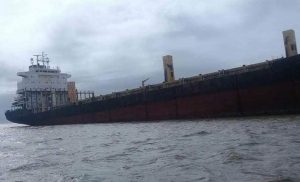
Even though the Sam Ratulangi disappeared over nine years ago, this tugboat had done what no one else apparently had, and found it in the middle of the ocean. Not willing to let this colossal ship drift around aimlessly any longer, the crew of the Independence hooked their tugboat to the Sam Ratulangi and began hauling it toward Bangladesh. So, while the mystery of how the Sam Ratulangi had disappeared, and how it avoided detection for nine years, as well as what happened to it cargo and crew, will likely never be known, the mystery of how it ended up of the Myanmar shore was solved.

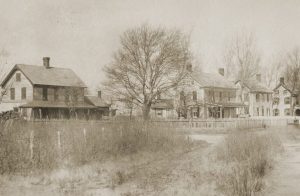 While islands don’t float and can’t flip over, they are subject to one hazard that can sometimes end with their disappearance…erosion. This isn’t a situation that many of us would ever notice in our lifetime, but on one island…Holland Island, located in the Chesapeake Bay, erosion quickly became a problem. In 1910, Holland Island, considered the most populated island in the Chesapeake Bay, was thriving with 360 residents. Besides historic Victorian homes, there were many other homes, shops, a school, and a church.
While islands don’t float and can’t flip over, they are subject to one hazard that can sometimes end with their disappearance…erosion. This isn’t a situation that many of us would ever notice in our lifetime, but on one island…Holland Island, located in the Chesapeake Bay, erosion quickly became a problem. In 1910, Holland Island, considered the most populated island in the Chesapeake Bay, was thriving with 360 residents. Besides historic Victorian homes, there were many other homes, shops, a school, and a church.
Despite its historic value, erosion gradually ate away at the island which greatly concerned its residents. Erosion just doesn’t care about historic value, sentimental value, or even about people’s lives. It is just a part of nature, and if a piece of ground doesn’t have a solid base, and plenty of vegetation to keep the ground in place, wind, rain, snow, and in this case, water from the bay will eventually erode the ground to a dangerous level. That was the situation that Holland Island found itself in 1910.
In 1914, in an attempt to try to slow the erosive loss of their precious island, the residents had stones shipped in to build walls and tried to even sink ships in an attempt to slow it down, but nothing worked. Finally, giving 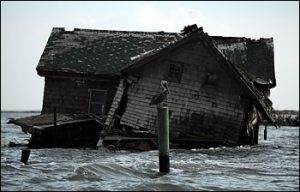
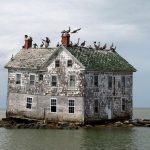 up, most of the residents tore down their homes and moved inland. Many of the buildings still remained, but the town was largely a ghost town. When a tropical storm hit in 1918, it damaged the church. By 1922, the few people who had stayed finally left after the church closed down. One man, in 1995, tried for 15 years to preserve the island, spending a fortune, all to no avail. Finally, the last house crumbled and fell, ending the fight to save Holland Island.
up, most of the residents tore down their homes and moved inland. Many of the buildings still remained, but the town was largely a ghost town. When a tropical storm hit in 1918, it damaged the church. By 1922, the few people who had stayed finally left after the church closed down. One man, in 1995, tried for 15 years to preserve the island, spending a fortune, all to no avail. Finally, the last house crumbled and fell, ending the fight to save Holland Island.

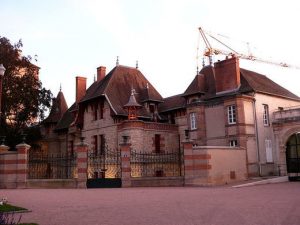 Louis Mantin, was a French aesthete, which is a person who has a special appreciation of art and beauty. He was also, “obsessed with death and the passage of time.” He wrote in his will that he wanted to turn his home into a museum after his death. He wanted to share his love of art, and his vast collection with others. However, his Will was very explicit in the details of how this would be carried out, and some might even say it was eccentric. In his will, he made a very specific and seemingly odd request, the museum would open 100 years after his passing.
Louis Mantin, was a French aesthete, which is a person who has a special appreciation of art and beauty. He was also, “obsessed with death and the passage of time.” He wrote in his will that he wanted to turn his home into a museum after his death. He wanted to share his love of art, and his vast collection with others. However, his Will was very explicit in the details of how this would be carried out, and some might even say it was eccentric. In his will, he made a very specific and seemingly odd request, the museum would open 100 years after his passing.
Mantin died in 1905, and though he made it very clear in his will what he wanted the house to be in 100 years, he didn’t make any provisions for the upkeep of the house in the meantime. Because nothing was specifically laid out, the house eventually fell into disrepair, because it was locked up and ignored. Eventually, worms and mold settled in among his statues and in the elaborate wallpaper. After a distant relative discovered Mantin’s will and initiated an extensive renovation project, the house was finally re-opened as a museum in 2010. It was five years late, but the will was finally carried out. I suppose that it took a little time to get the house back into a condition that would allow the house to become a museum.
Townspeople and tourists can now marvel at this once hidden world, that went completely untouched for a century, admiring Mantin’s eclectic collections, as well as his flushing toilet and heated floors, true luxuries for any home back in 1905. Mantin inherited a large fortune from his father, and since he was a bachelor, with no children, he used the money to start collecting the things that he loved. He was almost obsessive about it. 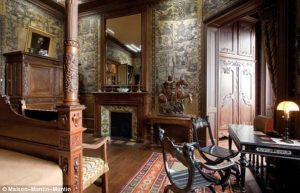
 Egyptian relics, medieval locks and keys, monkey skulls, and stuffed blowfish. Mantin had strange taste, and since he inherited the money later in life, he knew that his time with his newly acquired collection would be short. He decided that the logical solution was to turn his home into a museum. He thought people might like to know how an artistic gentleman had lived at the turn of the century. The museum might be filled with odd relics, but when you consider how rare they are, their value in the world of art would probably make them priceless.
Egyptian relics, medieval locks and keys, monkey skulls, and stuffed blowfish. Mantin had strange taste, and since he inherited the money later in life, he knew that his time with his newly acquired collection would be short. He decided that the logical solution was to turn his home into a museum. He thought people might like to know how an artistic gentleman had lived at the turn of the century. The museum might be filled with odd relics, but when you consider how rare they are, their value in the world of art would probably make them priceless.
 When a train derails, you know that there is going to be a big mess, and loss of life, or at the very least, injuries. And you would probably be right, but it would be a whole different situation, if multiple trains collided with each other. That is the exact scenario on January 17, 1929, in Aberdeen, Maryland, when two Pennsylvania Railroad passenger trains and a freight train all collided. While the collision was horrific, the loss of life was amazingly less that expected.
When a train derails, you know that there is going to be a big mess, and loss of life, or at the very least, injuries. And you would probably be right, but it would be a whole different situation, if multiple trains collided with each other. That is the exact scenario on January 17, 1929, in Aberdeen, Maryland, when two Pennsylvania Railroad passenger trains and a freight train all collided. While the collision was horrific, the loss of life was amazingly less that expected.
On that day, passenger train Number 412, bound from Washington to Philadelphia, struck the freight train, who was also northbound, just after it pulled from a siding, by Short Lane station, near Aberdeen. The freight cars toppled onto the southbound track, directly in front of express train Number 121, from New York to Washington. There was simply not time to avoid the disaster. The wreck killed four trainmen and seriously injured another. Conductors of the two passenger trains declared none of their passengers were seriously hurt. Brakeman, K. A. Klein, on the freight train, and flagman, V. W. Stewart, were both killed in the first crash; and engineer of the southbound express train, A. C. Terhune, and M. Goldstein, his fireman, were killed when their train ploughed into the wreckage.
Bodies of the two from the freight crew and of the passenger firemen were removed and taken to a morgue in Aberdeen, but the body of the express engineer was still under the engine five hours after the wreck. The workmen were prevented from recovering it by outpouring steam. Leon Sweeting, engineer of the northbound passenger train, was badly scalded and was taken to the Havre de Grace Hospital, where his condition was reported to be serious. John H. Lee, fireman on the same train, was in the hospital, suffering from shock.
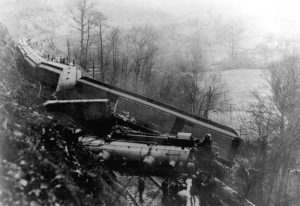
It is thought that heavy fog in the area, prevented the engineer of northbound number 412 from seeing the tail-light of the freight train right in front of him. Some passengers on the northbound and southbound trains were said to have been slightly injured, but none was reported in serious condition. The triple crash tore up about 150 yards of track and uprooted signal and telegraph poles. Trains had to be re-routed over the Baltimore and Ohio Railroad tracks, while relief trains were sent from Baltimore to Aberdeen. While this was not the worst wreck, in fatalities and injuries, I don’t recall too many, if any others involving three trains, and the experience must have been terrifying.
 On January 15, 2009, the whole world was captivated by the story of a miracle on the Hudson River. A pilot named Captain Chesley Burnett Sullenberger III, affectionately known as Sully, averted disaster after an unusual bird strike…meaning a flock of geese hit his plane, disabling both engines. Hitting a bird isn’t so uncommon, but to hit a flock can bring down a plane, and that was the situation Sully found himself in as he piloted US Airways Flight 1549 out of La Guardia Airport that morning. Just 60 seconds after takeoff, the horrific strike occurred.
On January 15, 2009, the whole world was captivated by the story of a miracle on the Hudson River. A pilot named Captain Chesley Burnett Sullenberger III, affectionately known as Sully, averted disaster after an unusual bird strike…meaning a flock of geese hit his plane, disabling both engines. Hitting a bird isn’t so uncommon, but to hit a flock can bring down a plane, and that was the situation Sully found himself in as he piloted US Airways Flight 1549 out of La Guardia Airport that morning. Just 60 seconds after takeoff, the horrific strike occurred.
Sully, a former fighter pilot with decades of flying experience, knew he was in a lot of trouble. After trying to restart the engines…a plan that failed, he made the mayday call. When air traffic controllers instructed the seasoned pilot to head for nearby Teterboro Airport, he calmly informed them that he was “unable” to reach a runway. “We’re gonna be in the Hudson,” he said simply, and then told the 150 terrified passengers and five crew members on board to brace for impact. I’m sure there were those who thought he should have tried for the airport, but if he had, he would have flown his plane into the buildings that were in the way. They had no chance of making it to Teterboro or back to La Guardia.
I’m sure the air traffic controllers and the passengers all thought that they had no chance of survival in the Hudson River either, but they were wrong. Ninety seconds later, Captain Sully quietly glided his Airbus 320 over the George Washington Bridge and onto the Hudson River midway between Manhattan and New Jersey. The flight attendants quickly instructed the passengers to put on life jackets and head for the exits over the wings. In minutes, 150 passengers and 5 crew members found themselves standing in ankle to knee deep river water on the wings of the plane that had, only moments before, been flying gracefully over the Hudson.
Of course, a commercial airliner can’t land on the busy Hudson River unnoticed. Immediately, the commuter ferries, sightseeing boats, and rescue vessels raced to the scene to pluck the frightened passengers fro a potential watery grave. The landing was so smooth that there were only two broken ribs, and minor injuries or hypothermia. One survivor suffered two broken legs and others were treated for minor injuries or hypothermia, but no fatalities occurred. After walking up and down the aisle twice to ensure a complete evacuation, Sullenberger was the last to leave the sinking plane. There were no fatalities, a concern that Sully took very seriously. He simply could not take a deep breath until he was told that all 155 souls had survived. For his actions, Sully received a slew of honors for his actions, including an invitation to Barack Obama’s presidential inauguration and resolutions of praise from the U.S. Congress.
Sully was now famous, with all that went with it, but he felt the need to retire, and find what really mattered to 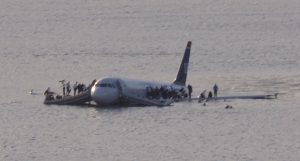 him. Yes, he would always be thankful that all 155 souls on US Airways Flight 1549 had survived, and they would always be grateful to him for having the skill to land safely in the Hudson, but he needed to focus on his family and his future. I don’t think he was afraid to fly anymore, but he just needed to get his priorities straight. Sully published a book about his childhood, military background and career entitled “Highest Duty: My Search for What Really Matters.” He retired from US Airways after 30 years in the airline industry on March 3, 2010, and has since devoted his time to consulting, public speaking and advocating for aviation safety.
him. Yes, he would always be thankful that all 155 souls on US Airways Flight 1549 had survived, and they would always be grateful to him for having the skill to land safely in the Hudson, but he needed to focus on his family and his future. I don’t think he was afraid to fly anymore, but he just needed to get his priorities straight. Sully published a book about his childhood, military background and career entitled “Highest Duty: My Search for What Really Matters.” He retired from US Airways after 30 years in the airline industry on March 3, 2010, and has since devoted his time to consulting, public speaking and advocating for aviation safety.
 Strange laws seem to be a part of our legal system. I suppose they might have had a purpose at some point, but somehow most of us just can’t see what it might have been. Section 18-54 of the Little Rock Arkansas city ordinances says, “No person shall sound the horn on a vehicle at any place where cold drinks or sandwiches are served after 9:00 p.m.” Immediately my mind begins to question this law, known as the Little Rock Sandwich Shop Law.
Strange laws seem to be a part of our legal system. I suppose they might have had a purpose at some point, but somehow most of us just can’t see what it might have been. Section 18-54 of the Little Rock Arkansas city ordinances says, “No person shall sound the horn on a vehicle at any place where cold drinks or sandwiches are served after 9:00 p.m.” Immediately my mind begins to question this law, known as the Little Rock Sandwich Shop Law.
It is mind boggling to think that this could have been such a constant problem  in Little Rock that it could require immediate legal intervention. And it wasn’t that honking in front of the sandwich shop was a problem all the time, just after 9 p.m. In reality, that isn’t even late. So, honking after 9 p.m. would get the culprit a citation and a fine, but what if you were trying to prevent an accident? Think about it. What a choice, have an accident, or get a ticket for trying to prevent one. So, with our accident, does the person who honked to prevent the accident get the ticket, or is it the guy who caused the accident, but obeyed the law, and didn’t honk.
in Little Rock that it could require immediate legal intervention. And it wasn’t that honking in front of the sandwich shop was a problem all the time, just after 9 p.m. In reality, that isn’t even late. So, honking after 9 p.m. would get the culprit a citation and a fine, but what if you were trying to prevent an accident? Think about it. What a choice, have an accident, or get a ticket for trying to prevent one. So, with our accident, does the person who honked to prevent the accident get the ticket, or is it the guy who caused the accident, but obeyed the law, and didn’t honk.
 Now, be aware that “drive-by honkings” that are performed prior to 9 p.m. are completely acceptable, so any sandwich shop heckling that you may have planned just had to be completed with this time frame in mind. I leave questions like these to be answered by those with more formidable legal minds than myself. My guess is that it had something to do with teenaged drivers, who were really just out for a good time, and wanted to say “Hello” to their friends. I suppose the adults didn’t like all the honking, but seriously, how early do these adults go to bed, or need their quiet time, anyway. Whatever the case may be…this was one law that could only be classified as ridiculous.
Now, be aware that “drive-by honkings” that are performed prior to 9 p.m. are completely acceptable, so any sandwich shop heckling that you may have planned just had to be completed with this time frame in mind. I leave questions like these to be answered by those with more formidable legal minds than myself. My guess is that it had something to do with teenaged drivers, who were really just out for a good time, and wanted to say “Hello” to their friends. I suppose the adults didn’t like all the honking, but seriously, how early do these adults go to bed, or need their quiet time, anyway. Whatever the case may be…this was one law that could only be classified as ridiculous.
 Several hundred people were employed by the Virginia Rubber and Tire Company in Saint Albans, West Virginia, on January 13, 1924. The business, located on 41 acres of land along the Kanawha River across from the present-day Ordnance Park (ca. 1941)…and before MacCorkle Avenue, was thriving in 1924. Established in 1920, it was only four years old. Unfortunately, the Virginia Rubber and Tire Company, was destined not to reach it’s fifth year. That fateful January day in 1924, brought with it a fire that destroyed the company, causing damage totaling $500,000.
Several hundred people were employed by the Virginia Rubber and Tire Company in Saint Albans, West Virginia, on January 13, 1924. The business, located on 41 acres of land along the Kanawha River across from the present-day Ordnance Park (ca. 1941)…and before MacCorkle Avenue, was thriving in 1924. Established in 1920, it was only four years old. Unfortunately, the Virginia Rubber and Tire Company, was destined not to reach it’s fifth year. That fateful January day in 1924, brought with it a fire that destroyed the company, causing damage totaling $500,000.
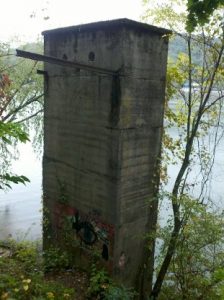
While I was unable to find much information as to the time and cause of the fire, it is noted that only about 10 percent of the tire stock was saved, and the rest was burned. That isn’t really surprising, since rubber tires are highly flammable. Unfortunately, it also doesn’t appear that all of the loss was covered by the company’s insurance. As an insurance agent, I can say that a property loss that was not completely covered by insurance could only mean that the company was underinsured, leaving gaps in the coverage. What is known about the loss is that the unpaid portion was enough to ensure that the company could never open their doors again. That meant that several hundred people were out of a job, and while they didn’t know it, the Great Depression was coming up quickly. I’m sure they all had jobs before that time, but it was quite likely that they would lose their jobs when that 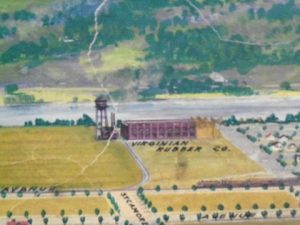 time came.
time came.
The good news about the fire was that it took no lives. The only loss was to the property. Nevertheless, the town would never be quite the same again. Other businesses would grow up where the rubber company had once been, but mostly it would be remembered as the site of Morgan’s Plantation Kitchen, originally established in 1846. I supposed the site went back to it’s former identity. Still, the total loss of the Virginia Rubber and Tire Company, manufacturer of tires, tubes, toy balloons, balls, and rubber dolls, would not be forgotten.
 After the discovery of gold in California, people went crazy…mad really for gold. For twenty years, in fact, all the West was mad for gold. People packed up their lives, and headed west, hoping to dig their fortune out of the California dirt. At first, the people heading west were mostly men, but there were families that went too. It didn’t really matter who it was, when it came to gold, people were willing to fight to the death for what was theirs, or for what they wanted. Greed was the word of the day, and it was a disease that everyone in California had.
After the discovery of gold in California, people went crazy…mad really for gold. For twenty years, in fact, all the West was mad for gold. People packed up their lives, and headed west, hoping to dig their fortune out of the California dirt. At first, the people heading west were mostly men, but there were families that went too. It didn’t really matter who it was, when it came to gold, people were willing to fight to the death for what was theirs, or for what they wanted. Greed was the word of the day, and it was a disease that everyone in California had.
The Gold Rush brought honest citizens and outlaws alike to California. People had to be on guard at all times. If someone struck gold, they were an immediate target for anyone willing to steal their gold, or even to kill for it. The mad rush for gold soon spread to other areas of the United States. The gold-hunters, no longer content with California, began to prospect lower Oregon, upper Idaho, and Western Montana too. They figured that if one place had gold, why wouldn’t another place have it too. And with the slightest discovery, came the craziness of Gold Dust Fever.
With Gold Fever came the sinister figure of the trained desperado, the professional bad man. The business of 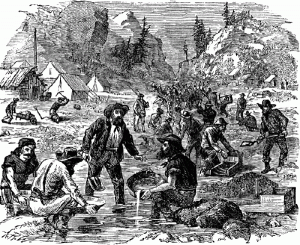 being an outlaw was turned into one highly organized profession that was relatively safe and extremely lucrative. There was wealth to be had for the asking or the taking, and these men, and sometimes women, were willing. Each miner had his buckskin purse filled with native gold. This dust was like all other dust. It could not be traced nor identified; and the old saying, ”’Twas mine, ’tis his,” might here of all places in the world most easily become true. There were no checks, drafts, or currency, as we know it now. The normal means by which civilized men keep a record of their property transactions, were unknown. The gold scales established the only currency, and each man was his own banker, obliged to be his own peace officer and the defender of his own property. It was a wild world. It was a world mad for gold.
being an outlaw was turned into one highly organized profession that was relatively safe and extremely lucrative. There was wealth to be had for the asking or the taking, and these men, and sometimes women, were willing. Each miner had his buckskin purse filled with native gold. This dust was like all other dust. It could not be traced nor identified; and the old saying, ”’Twas mine, ’tis his,” might here of all places in the world most easily become true. There were no checks, drafts, or currency, as we know it now. The normal means by which civilized men keep a record of their property transactions, were unknown. The gold scales established the only currency, and each man was his own banker, obliged to be his own peace officer and the defender of his own property. It was a wild world. It was a world mad for gold.
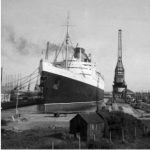 One of the most elegant ships ever built, RMS Queen Elizabeth, was one of the two superliners built by John Brown and Company in Clydebank, Scotland, in the 1930s. The ship did not start out as RMS Queen Elizabeth, but rather as Hull 552. Later, it was named in honor of Queen Elizabeth, and launched, on 27 September 1938. The RMS Queen Elizabeth was 1,031 feet long and 118.5 feet wide. It was the largest passenger liner ever constructed…until then anyway.
One of the most elegant ships ever built, RMS Queen Elizabeth, was one of the two superliners built by John Brown and Company in Clydebank, Scotland, in the 1930s. The ship did not start out as RMS Queen Elizabeth, but rather as Hull 552. Later, it was named in honor of Queen Elizabeth, and launched, on 27 September 1938. The RMS Queen Elizabeth was 1,031 feet long and 118.5 feet wide. It was the largest passenger liner ever constructed…until then anyway.
During the late 1930s, workers at a Scottish construction site began building a sea vessel for the Cunard Line ocean liner company that would be larger and more luxurious than anything the world had ever seen. However, the outbreak of World War II in 1939 prevented the completion of the Queen Elizabeth‘s finer points. The vessel was hastily made seaworthy for wartime service and was used as a transport vessel for the Allies, carrying massive amounts of supplies and several hundred thousand troops around the world until the war’s end. Because of the concerns over German bombing, the ship was moved to New York to harbor it in a safer place.
After the war, the ship, which was equipped with a 200,000 horsepower engine, was embellished with an elegant art deco style. It made its public debut in 1946, leaving Southampton, England, on its first luxurious 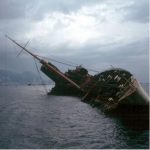 run across the Atlantic. The ship continued to be a luxury passenger liner until it retirement in 1968.
run across the Atlantic. The ship continued to be a luxury passenger liner until it retirement in 1968.
Then, the Queen Elizabeth was auctioned off to the highest bidder, eventually being purchased in 1970 by C.W. Tung, a Taiwanese shipping tycoon. Tung renamed the vessel Seawise University and began work on converting the ship into a learning center that would tour the world. However, in early 1972, as the mobile university neared completion, a fire destroyed the pride of the Cunard Line. The fire broke out while the ship was docked in Hong Kong Harbor, and by the next morning the famous vessel was a total loss on the bottom of the sea floor.
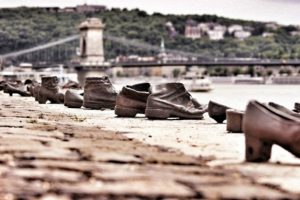 While looking at some historic photos, I came across one that was both intriguing, and sad. The title of the photograph was as intriguing as the photograph itself. Shoes on the Danube Banksdepicts a memorial in Budapest, Hungary that was conceived by film director Can Togay. The memorial sits on the east and of the Danube River. Togay worked with sculptor Gyula Pauer to create a memorial to honor the Jews who were killed by fascist Arrow Cross militiamen in Budapest during World War II.
While looking at some historic photos, I came across one that was both intriguing, and sad. The title of the photograph was as intriguing as the photograph itself. Shoes on the Danube Banksdepicts a memorial in Budapest, Hungary that was conceived by film director Can Togay. The memorial sits on the east and of the Danube River. Togay worked with sculptor Gyula Pauer to create a memorial to honor the Jews who were killed by fascist Arrow Cross militiamen in Budapest during World War II.
As I looked at the picture of many pairs of shoes, the magnitude of what had happened there, and exactly what I was looking at hit me. These shoes were not just shoes, they were people…innocent people, who lined up and shot for no other reason than that they were Jewish. These people were told to remove their shoes, and then they were shot. Their lifeless bodies fell into the river and were swept downstream. There was no funeral, no burial…despite the traditions that are set up for Jewish burial. Of course, I know that not every Jewish death can be handles in the Jewish traditions, but these people were murdered in such a way as to humiliate them, including the lack of a traditional burial.
The monument along the Danube River represents the lives of the people who were murdered, there is no way to really represent the people, because no one knows who they were, what they looked like, or even how many there were for sure, but rather the monument depicts their shoes left behind on the bank. It is the only real connection we can have to these victims of such horrible hatred. The brutal treatment of the approximately 3,500 people, 800 of them Jews, and the rest accused of Jewish activities, is beyond horrid. These people were forced to strip naked on the banks of the Danube and face the river. Then, a firing squad shot the prisoners at close range in the back so that they fell into the river to be washed away.
The monument is located on the Pest side of the Danube Promenade in line with where Zoltan Street would meet the Danube if it continued that far, about 980 feet south of the Hungarian Parliament and near the Hungarian Academy of Sciences…between Roosevelt Square and Kossuth square. The sculptor created sixty pairs of period-appropriate shoes out of iron. The shoes are attached to the stone embankment, and behind them lies a 131 foot long, 27 inch high stone bench. At three points are cast iron signs, with the following text in Hungarian, English, and Hebrew: “To the memory of the victims shot into the Danube by Arrow Cross militiamen in 1944–45. Erected 16 April 2005.”
Most of the murders along the edge of the River Danube took place around December 1944 and January 1945, when the members of the Arrow Cross Party police (“Nyilas”) took as many as 20,000 Jews from the newly established Budapest ghetto and executed them along the river bank. There were, of course, some survivors who managed to make it out, and lived to tell their stories. On of those Was Tommy Dick, who wrote the book, “Getting Out Alive.” I have not read the book yet, but after seeing this memorial, I will be reading it very soon.
There were heroes in Budapest too. Valdemar Langlet, head of the Swedish Red Cross in Budapest, with his wife Nina, and later the diplomat Raoul Wallenberg and 250 coworkers were working around the clock to save the Jewish population from being sent to Nazi concentration camps. This group later grew in number to approximately 400. Lars and Edith Ernster, Jacob Steiner, and many others were housed at the Swedish Embassy in Budapest and 32 other buildings throughout the city which Wallenberg had rented and declared as extraterritorially Swedish to try to safeguard the residents. Italian Giorgio Perlasca did the same, sheltering Jews in the Spanish Embassy.
On the night of January 8, 1945, an Arrow Cross execution brigade forced all the inhabitants of the building on  Vadasz Street to the banks of the Danube. At midnight, Karoly Szabo and 20 policemen with drawn bayonets broke into the Arrow Cross house and rescued everyone. Among those saved were Lars Ernster, who fled to Sweden and became a member of the board of the Nobel Foundation from 1977 to 1988, and Jacob Steiner, who fled to Israel and became a professor at the Hebrew University of Jerusalem. Steiner’s father had been shot dead by Arrow Cross militiamen 25 December 1944, and fell into the Danube. His father had been an officer in World War I and spent four years as a prisoner of war in Russia. These were horrific murders, and after looking at the pictures of this memorial and reading about the horrible murders, my mind cannot unsee the images it has conjured up of this atrocity.
Vadasz Street to the banks of the Danube. At midnight, Karoly Szabo and 20 policemen with drawn bayonets broke into the Arrow Cross house and rescued everyone. Among those saved were Lars Ernster, who fled to Sweden and became a member of the board of the Nobel Foundation from 1977 to 1988, and Jacob Steiner, who fled to Israel and became a professor at the Hebrew University of Jerusalem. Steiner’s father had been shot dead by Arrow Cross militiamen 25 December 1944, and fell into the Danube. His father had been an officer in World War I and spent four years as a prisoner of war in Russia. These were horrific murders, and after looking at the pictures of this memorial and reading about the horrible murders, my mind cannot unsee the images it has conjured up of this atrocity.

